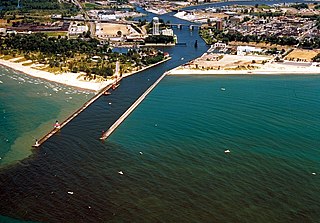
The Fairlie–Poplar Historic District is part of the central business district in downtown Atlanta. It is named for the two streets that cross at its center, northeast-only Fairlie and southeast-only Poplar. Fairlie–Poplar is immediately north of Five Points, the definitive centerpoint and longtime commercial heart of Atlanta. It is roughly bounded on the southwest by Marietta Street, on the southeast by Peachtree Street or Park Place, on the northeast by Luckie Street or Williams Street, and on the northwest by Cone Street or Spring Street. It has smaller city blocks than the rest of the city, and the streets run at a 40° diagonal.

The Main Street Historic District encompasses the historic commercial center of Middletown, Connecticut, United States. Middletown was one of the most important ports on the Connecticut River during the colonial period, and Main Street "has been the center of community life since the earliest period of settlement". Today Main Street is home to a number of 19th century buildings, maintaining the bulk of its historic character. It was listed on the National Register of Historic Places in 1983.

The Downtown New London Historic District, also known as the Waterfront Historic District, refers to 78 acres (32 ha) with 223 contributing buildings along the waterfront of New London, Connecticut. It was added to the National Register of Historic Places (NRHP) in 1979, with 190 buildings and 60 acres (24 ha). The district was expanded in 1988, adding 18 acres (7.3 ha) and 33 buildings.

The Farmer's and Manufacturer's Bank building is located at the corner of Market and Cannon Streets in downtown Poughkeepsie, New York, United States, near the Bardavon and across from the Dutchess County Court House and Old Poughkeepsie YMCA. It is one of only two non-residential Greek Revival buildings remaining in the city.

The Wakefield Trust Company is a historic commercial building at 371 Main Street in Wakefield, Massachusetts. Built in 1924, it is one of three buildings on the west side of Main Street that give the town center a strong Classical Revival flavor. The building was listed on the National Register of Historic Places in 1989.
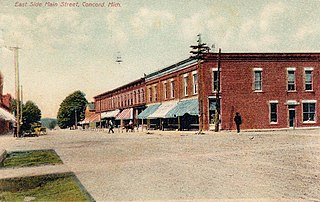
The Concord Village Historic District in Concord, Michigan dates back to 1836, and consists of historic structures located along Hanover Street from Spring to Michigan Streets and North Main Street from Railroad to Monroe Streets. It was listed on the National Register of Historic Places in 1996.

The Downtown Adrian Commercial Historic District is a historic district comprising the downtown area of Adrian, Michigan. It was designated as a Michigan Historic Site and added to the National Register of Historic Places on April 17, 1986. The district is roughly bounded on the north by Toledo Street, on the east by North Broad Street, on the south by East Church Street, and on the west by North Winter Street (M-52), West Maumee Street, and the River Raisin. Most of the district is enclosed by the US-223 Business Route, although the two are not conterminous.

Valparaiso has retained an active downtown. It remains a mix of government, retail and business center, with a mixed residential and service area. Numerous economic changes have not changed the basic character, historic courthouse area. The historic district retains the distinctive turn-of-the-19th-century architecture, supporting numerous small specialty shops, shaded sidewalks, and a people friendly environment. The Downtown District, is anchored on the Porter County Courthouse. It includes 14-blocks surrounding the square, bounded on the north by Jefferson Street, on the east by Morgan Street, on the south by Monroe Street, and on the west by Napoleon Street.
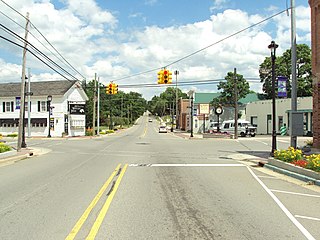
The Metamora Crossroads Historic District is a historic district centered at the intersection of Oak and High Street in the small village of Metamora in Metamora Township in Lapeer County, Michigan. It was designated as a Michigan State Historic Site and also added to the National Register of Historic Places on July 19, 1984.
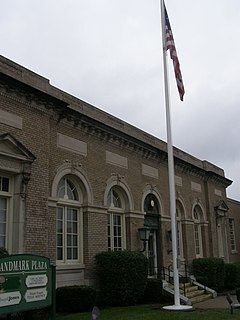
The Old U.S. Post Office in Niles, Michigan is a Classical Revival building that was built in 1909. It was listed on the National Register of Historic Places in 1985.

The Farmers Bank Building is a historic commercial building at Main and Walnut Streets in Leslie, Arkansas. It is a single-story brick structure, with its entrance angled at the street corner. The main facade is three bays wide, all with round arches trimmed in limestone. Built about 1910, this Romanesque Revival building house the Farmers Bank until it failed in the 1930s, and then the local post office for a time.

The State Bank of Stratford is a historic building located in Stratford, Iowa, United States. The bank opened for business in 1891, eight years after the town was incorporated. Its early success reflected the prosperity in rural Iowa at the time. The bank occupied this corner since 1910, and this building was completed in 1918. The older building was relocated to the west, and it is still extant. It survived the agricultural economic downturn of the 1920s, but it could not survive the Great Depression. The bank building was purchased in 1936 by the Farmer's Savings Bank, which operated in this building until a new bank building was built across the street to the south. The Georgian Revival elements of the building include the pedimented entrance portico, elliptical arched windows, the brick quoining on the corners, and the dentilated cornice. The building was listed on the National Register of Historic Places in 1983.
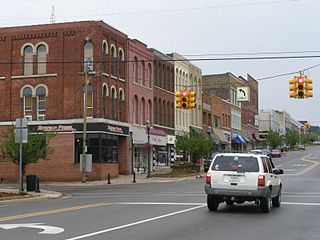
The Niles Downtown Historic District is a commercial historic district located in Niles, Michigan along Sycamore, Main and Cedar Streets between Front and 5th. The districts was listed on the National Register of Historic Places in 2007.
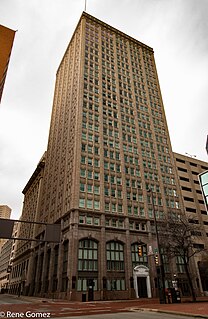
The Farmers and Mechanics National Bank is located at 714 Main Street in Fort Worth, Texas, at the corner of Main and Seventh streets. Designed in the Chicago Style the building was constructed in 1921. It was designed by the prominent architectural firm Sanguinet and Staats. The building was constructed during a time when Fort Worth was experiencing tremendous growth as a result of the oil and cattle industry. It remained the tallest building in Fort Worth until 1957. The building was vacant from 1997 until 2007 when XTO purchased the building and started renovations.

The South Monroe Street Historic District is a primarily residential historic district located at 89-175 and 90-146 South Monroe Street, and 17 Park Avenue, in Coldwater, Michigan. It was listed on the National Register of Historic Places in 1990. It is the best-preserved section of modest houses constructed in Coldwater in the 1850s-1870s, and contains the former Lake Shore & Michigan Southern depot, constructed in 1883.
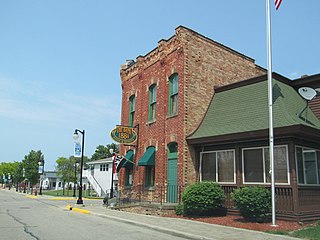
The Winsor and Snover Bank Building is a commercial structure located at 8648 Lake Street in Port Austin, Michigan. It was listed on the National Register of Historic Places in 1987. As of 2017, the building houses The Bank, 1884 restaurant.

The East Michigan Avenue Historic District is a residential historic district located at 300-321 East Michigan Avenue, 99-103 Maple Street, and 217, 300 and 302 East Henry in Saline, Michigan. It was listed on the National Register of Historic Places in 1985.

Nickels Arcade is a commercial building located at 326-330 South State Street in Ann Arbor, Michigan. It was listed on the National Register of Historic Places in 1987. The building is notable as perhaps the only remaining example in Michigan of a free-standing commercial arcade building that was popularized by the Cleveland Arcade.

The Farmers and Mechanics Bank is a historic building in the Georgetown neighborhood of Washington, D.C. Constructed between 1921 and 1922, the bank was first the headquarters of the Farmers and Mechanics National Bank. Soon thereafter, it became known as the Farmers and Mechanics Branch of Riggs National Bank. In 2005, the building became a branch of PNC bank.






